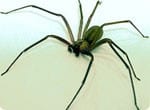In Big Cities More Insects And Spiders Live Indoors Than Outdoors
Not long ago, researchers in North Carolina conducted the first ever study that explored indoor insect and spider populations. The study found that insect and spiders populations within houses are much larger than previously assumed, and all houses contain a significant amount of insects and spiders of many different species. Also, it turns out that the cleanest and most expensive homes contain larger insect habitats than dirtier and cheaper homes. Ever since this study was published, researchers have been scrambling to conduct further studies on this topic. For example, Dr. Rob Dunn, an applied ecologist at North Carolina State University, is hoping to learn how indoor insect populations differ across the globe.
You can understand how difficult it must be to assess insect and spider populations within houses located in every region of the world. In order to gather data, Dr. Dunn is asking people all over the world to take pictures of the insects and spiders that they find within their homes before sending them to Dr. Dunn. Dunn’s goal is to collect 10,000 pictures of insects and spiders that are located indoors. Dr. Dunn is convinced that understanding the insect and spider population as a whole means knowing which insects and spiders exist indoors. The doctor may be onto something, as a 2001 study found that of all the insects that dwell within the world’s densest cities, most of them can be found indoors. Of course, this is only the case when an equal amount of outdoor and indoor land area is being compared. However, the amount of land space in Manhattan is greater than the amount of outdoor space by a ratio of three to one, meaning that a majority of Manhattan’s insects reside indoors. Considering the massive cockroach population in New York’s apartments, this may not be much of a surprise.
Dr. Dunn has not yet completed his study of worldwide indoor insect populations, but he and his team have already determined that most countries share a similar sized insect population within structures, no matter the country’s climate. For example, structures in Sweden and Peru contain a roughly equal amount of insects. Therefore, focusing on indoor insect habitats could be more scientifically fruitful than studying the insect habitat in the Amazon. What is not yet known is how indoor insects find enough food and water required for survival, and how such a diverse insect population can coexist within a relatively small space.
Do you think that some insect species are more given to surviving indoors than other insect species?






